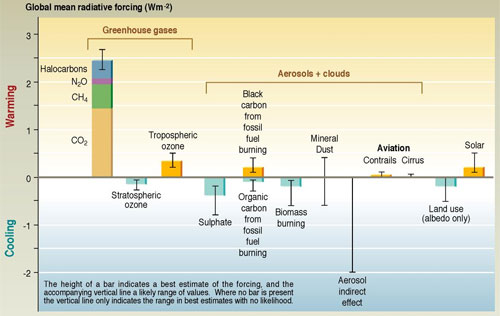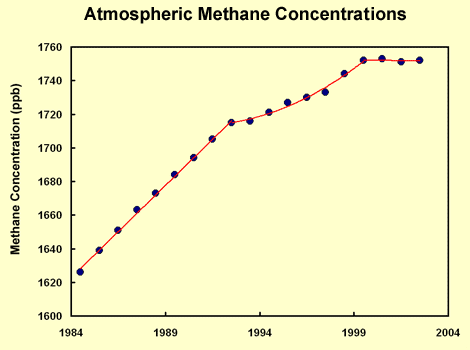What is methane's contribution to global warming?
What the science says...
| Select a level... |
 Basic
Basic
|
 Intermediate
Intermediate
| |||
|
While methane is a more potent greenhouse gas than CO2, there is over 200 times more CO2 in the atmosphere. Hence the amount of warming methane contributes is 28% of the warming CO2 contributes. |
|||||
Climate Myth...
It's methane
"A United Nations report has identified the world's rapidly growing herds of cattle as the greatest threat to the climate, forests and wildlife. ...
...Livestock are responsible for 18 per cent of the greenhouse gases that cause global warming, more than cars, planes and all other forms of transport put together.
Burning fuel to produce fertiliser to grow feed, to produce meat and to transport it - and clearing vegetation for grazing - produces 9 per cent of all emissions of carbon dioxide, the most common greenhouse gas. And their wind and manure emit more than one third of emissions of another, methane, which warms the world 20 times faster than carbon dioxide." (Geoffrey Lean)
While methane is a more potent greenhouse gas than CO2, there is over 200 times more CO2 in the atmosphere. Eg - CO2 levels are 380 ppm (parts per million) while methane levels are 1.75ppm. Hence the amount of warming methane contributes is calculated at 28% of the warming CO2 contributes. Here is a graph of the various forcings that influence climate (methane is CH4, right above CO2).

This is not to say methane can be ignored - reducing methane levels is definitely a goal to pursue. The good news is since the early 1990's, the trend in increasing methane has slowed down and even leveled off in the last few years (Dlugokencky 2003).

Last updated on 26 October 2016 by John Cook. View Archives































 Arguments
Arguments



































[DB] Recent topical discussion on Methane over at Tamino's.
Chris Colose, Eli Rabett (and also here) and Steve Bloom all weigh in with good points.
Methane levels started to increase again, about 6 or 7 years ago, so this explanation needs updating.
the more important point is that agriculture itself (minus land-use issues, transportation, pesticides, etc) should be carbon neutral, in the long run. the methane only takes a few years to decay back into c02, and then it gets recycled. if you ignore the transportation, and you take the pesticides out, and you offset the land-use with new planting, there isn't a net increase - it's just a redistribution from the soil to the trees, which can then be pulled back to the soil.
this argument is still floating around. that's the key point in combatting it: the only net source of carbon into the atmosphere is from underground, that is fossil fuels. organic farming with proper offsets for clearing is (excluding transportation issues) actually carbon neutral in the long run.
So, you are saying why Carbon-Soil Initiatives will never be an accepted method to combat climate change?!!?
Deathtokoalas - that's a lot of factors you're asking us to ignore, and they are factors that are not being dealt with so I'm not sure why we should ignore them. What matters it the current impact of agriculture, not what it could be if we wished away various aspects of it, wouldn't you say?
Your argument is misleading. Increased rumination due to our apetite for animal flesh puts methane and the resulting CO2 and water vapor into the atmosphere. This is the bottom line - as long as these animals release gas, this will remain true. Where would the constituents of methane be if they were not being farted out? They would be in trees that would be, on net, absorbing CO2 instead of releasing it. When the trees die, their carbon returns beneath ground (unless we burn the wood).
So the effect of clearing massive swathes of forest (which is not being offset by replanting), plus pushing carbon from plant growth into methane and up into the atmosphere, is not neutral at all... or am I missing something?
I've done some calculations and got to the following point and would like someone please to tell me where I've gone wrong.
My question is "what are the relative contributions of greenhouse gases to the excess heating we experience this year?"
Firstly, for excess we need to take the difference from pre-industrial levels, so CO2 is (2011 levels) 391 - 278 = 113 ppm and for methane is 1.803 - 0.7 = 1.103 ppm.
Second is the rel warmoing potential which for CO2 is 1 and for methane over a 100 year period is 28. But that 28 is because methane progressively breaks down in to CO2 so for the last 50 years or so most of the methane has disappeared. To calculate the warming potential of methane right now I took the 100 year number, the 20 year number of 84, took logs and extrapolated back to 0 to get a native number of 110.
so
contribution from CO2 = 113 x 1 = 113
contribution from CH4 = 1.103 x 110 = 121
Hence the extra warming generated this year comes slightly more from methane than from CO2.
I've tried to work out what is wrong with this but have failed. Can anyone help?
thanks
@23 Dipper:
Your math seems to be correct!
I think the problem is that the warming potential for CO2 vs. methane compares units of mass while your calculation compares units of volume.
CO2 is 2.75 times heavier per molecule (or ppm) than methane, so the numbers for methane have to be divided by that if you are comparing the climate impact from each on a ppm basis.
Doing that, you get these results for methane vs. CO2:
100 years: 28 / 2.75= 10.2
20 years: 84 / 2.75 = 30.5
Instantly: 110 / 2.75 = 40
And from pre-industrial to 2011:
CO2: 113
Methane: 121 / 2.75 = 44
This figure shows the annual growth of forcings from the well-mixed greenhouse gases after 1950. Since the late 1990s the contribution from non-CO2 has only been about 20-25 %, but that fraction was up to 50 % until the early 1990s. Note that the methane forcing nearly stabilized in the early 2000s, but has started to increase again.
Dipper @23, the Global Warming Potential is defined by the IPCC as follows:
You will notice that, first, the GWP is a function of mass, not volume (as pointed out by HK @24); and, second, that it is a function of emitted mass, not atmospheric concentration.
If you want to calculate the relative effect from atmospheric concentrations, you just use the formula for radiative forcing.
Thus, for CO2, the formula is 5.35 x ln(C/Co), which for the values you give is 1.82 W/m^2.
For Methane, the formula is ΔF = 0.036(M½ - Mo½) - [f(M,No) - f(Mo,No)]
where f(M,N) = 0.47ln[1 + 2.01x10-5 (MN)0.75 + 5.31x10-15M(MN)1.52] and M stands for a Methane concentration, and N stands for a Nitrogen Oxide concentration.
Ignoring the Nitrous Oxide adjustment, and using your figures, this yields Methane forcing of 0.02 W/m^2, or 1/91st of the forcing due to CO2. There is a further, small adjustment due to the relative effectiveness of different forcings but it does not bridge the gulf in the relative impacts between the two. The result is that, per unit concentration, methane is approximately 12% more effective at warming than CO2 at near current cocentrations, but the significantly larger increase in CO2 concentration means that CO2 is the primary warmer.